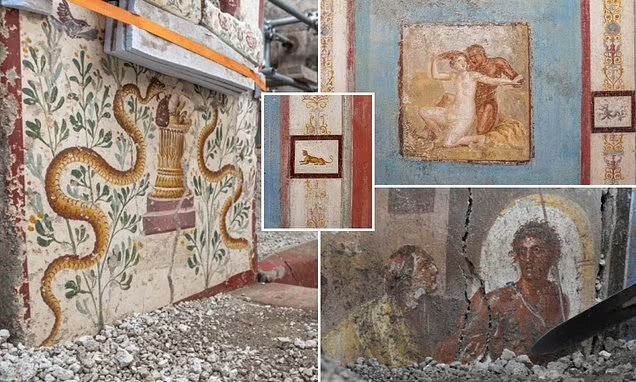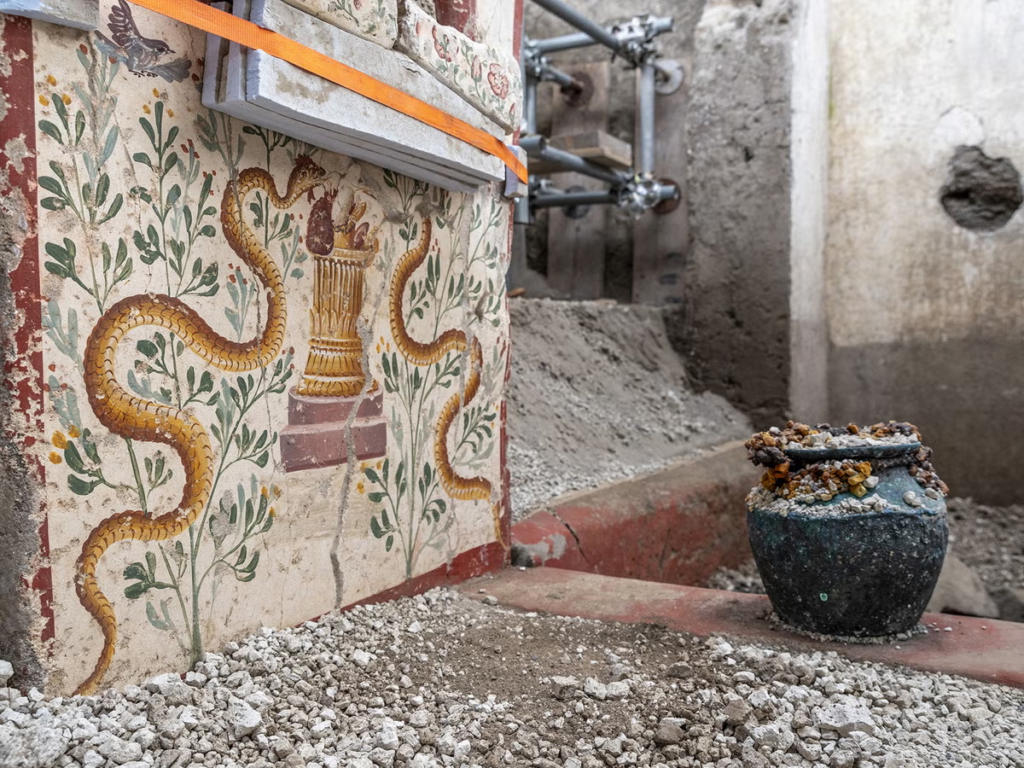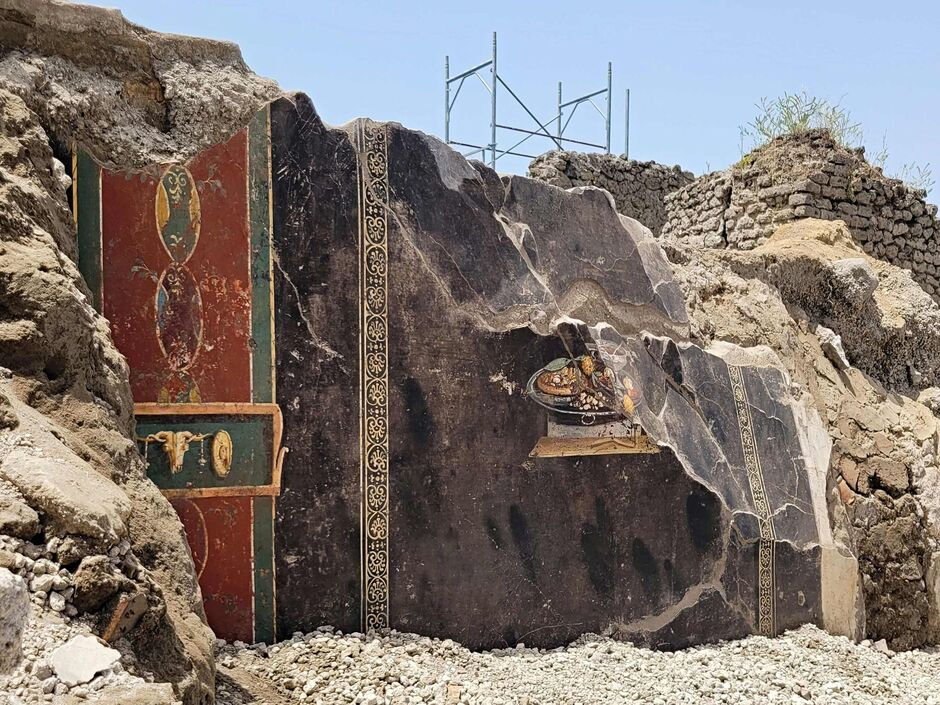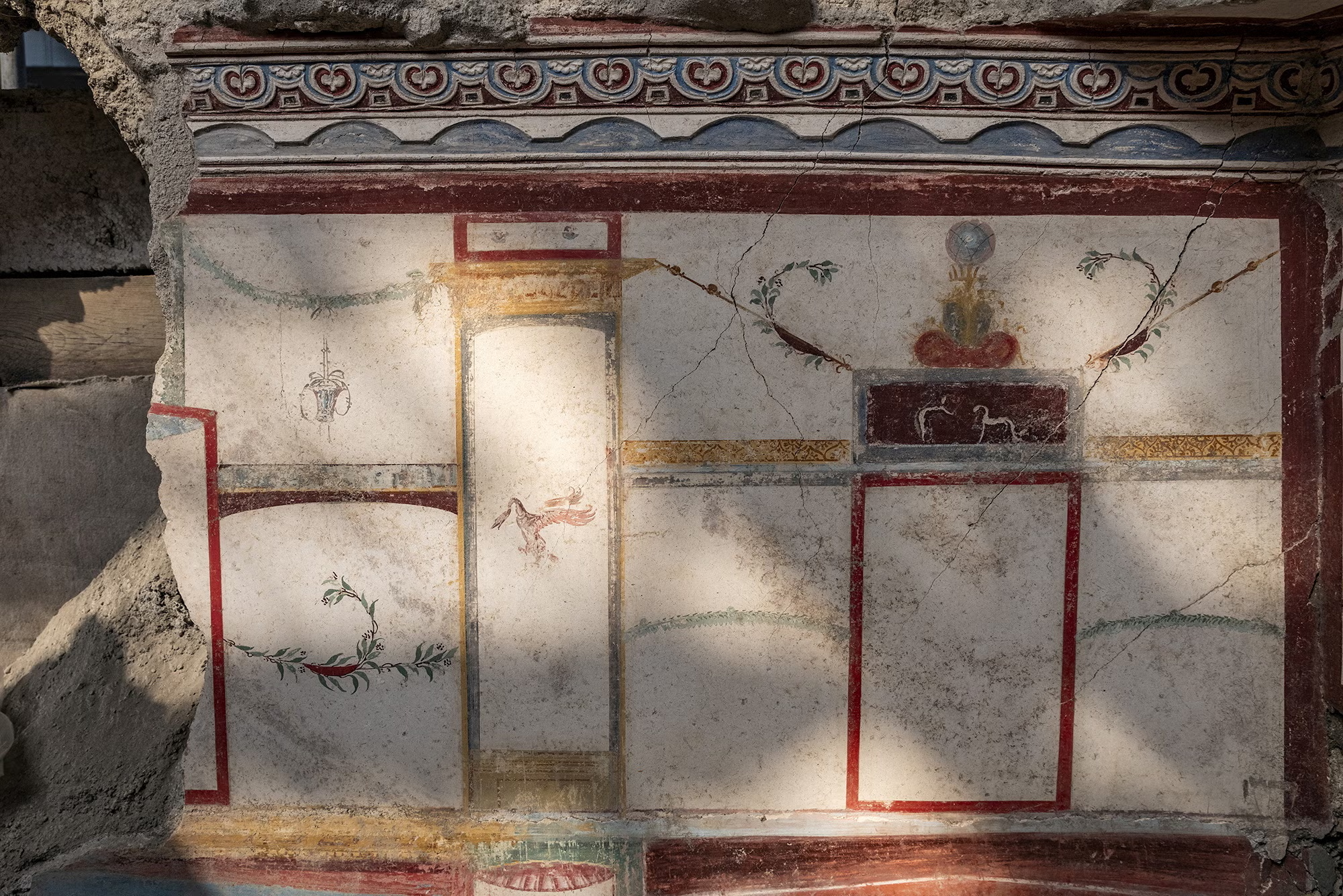In an exciting revelation for archaeology enthusiasts and historians alike, a tiny house brimming with intricate artwork has been discovered in the heart of Pompeii.
This find, located in the Insula dei Casti Amanti district, showcases remarkable frescoes and provides invaluable insights into the lives of the city’s inhabitants before the catastrophic eruption of Mount Vesuvius in 79 A.D.
The discovery not only highlights the artistic capabilities of the time but also offers a window into the cultural and spiritual life of ancient Pompeii.
The Historical Context of Pompeii
Pompeii, a bustling Roman city, was famously preserved under layers of volcanic ash for nearly 2,000 years. Its sudden burial during the eruption of Mount Vesuvius allowed for the exceptional preservation of buildings, artifacts, and even the remains of its residents.
The city offers a unique snapshot of Roman life at the height of its power, with streets lined with shops, temples, and homes adorned with stunning artwork. Each excavation at Pompeii uncovers more about its inhabitants, their daily lives, social structures, and artistic expressions, helping to piece together the narrative of this ancient civilization.
Read : Amalfi Coast of Italy: Where Sea Meets Sky to Share Captivating Tales of Sunlit Shores
The eruption of Vesuvius was a catastrophic event that not only destroyed the city but also provided a time capsule for future generations. The layers of ash that covered Pompeii preserved buildings, frescoes, and everyday items in remarkable detail, allowing archaeologists to study them in a state that is closer to their original condition than many other archaeological sites.
As excavations continue, each new discovery adds depth to our understanding of Roman society, culture, and the events that shaped their world.
Discovery of the Tiny House
The recent excavation that led to the discovery of the tiny house is part of ongoing efforts to uncover the residential areas of Pompeii, focusing on the lesser-known districts. This particular house, although small compared to the grand villas typically associated with the elite of Pompeii, is a testament to the artistic and architectural innovations of the time. \
Archaeologists believe that the size of the house indicates it may have belonged to a middle-class family or perhaps a tradesperson, suggesting that even those of modest means had a deep appreciation for art and culture.
The house was found remarkably intact, with many of its walls still standing and adorned with exquisite frescoes that tell stories of mythology, love, and spirituality.
Read : Pompeii and Beyond: Journeying through Italy’s Ancient Ruins
The preservation of this house is a rare opportunity to study the domestic architecture of Pompeii, as well as the artistic styles that were popular at the time. The intricate details of the frescoes provide clues about the beliefs, values, and everyday lives of its inhabitants, offering a glimpse into a world that has long since vanished.
The Artwork: A Reflection of Roman Culture
The frescoes discovered within the tiny house are nothing short of extraordinary. They are characterized by vibrant colors, intricate details, and a wide array of mythological themes. One of the most prominent themes in the artwork is the portrayal of mythological stories, which were essential to Roman culture.
These tales often served not just as entertainment but as moral lessons and reflections on the human experience. One of the most striking frescoes illustrates the tragic myth of Hippolytus and Phaedra, a story that explores themes of desire, betrayal, and familial conflict.

This particular depiction is notable for its emotional intensity and detailed representation of the characters, which is characteristic of the skilled artists of the time. The fresco captures the moment of Phaedra’s confession to Hippolytus, emphasizing the turmoil of their relationship and the dramatic consequences that follow.
Additional Mythological Themes
Alongside the Hippolytus and Phaedra fresco, the tiny house also features imagery from other well-known myths. The Judgment of Paris, a tale of beauty and choice that ultimately leads to the Trojan War, is depicted with striking detail.
The composition of the fresco highlights the tension among the goddesses Hera, Athena, and Aphrodite as they vie for Paris’s favor. This myth was not only popular in Roman times but also served as a commentary on beauty, desire, and the often complicated nature of human relationships.
Another notable fresco depicts Venus and Adonis, celebrating love and beauty, which were central themes in Roman society. This imagery reflects the societal values of the time, where the idealization of love and beauty was prevalent in art, literature, and daily life.
The careful attention to detail in the portrayal of the figures suggests that the inhabitants of the house placed significant importance on these cultural narratives, using them to convey their aspirations and beliefs.
Spiritual Significance: Ritual Artifacts
In addition to the stunning frescoes, archaeologists discovered various ritual artifacts within the house. These items provide further insight into the spiritual practices of the time, suggesting that the residents engaged in rituals to honor their deities and seek protection. Among the findings were an incense burner, a lamp with burn marks, and remnants of dried fruits, including figs.
The presence of the incense burner indicates that the residents likely performed rituals involving offerings to the gods, perhaps as a form of prayer or thanksgiving. Incense played a crucial role in ancient Roman religious practices, often used to purify spaces and create an atmosphere conducive to spiritual activities.
The lamp, which shows signs of use, may have illuminated the space during these rituals, further emphasizing the importance of light in spiritual and domestic life.
Ritual Offerings and Everyday Life
The discovery of the ritual offerings paints a vivid picture of the household’s spiritual life. The dried fig, found alongside other offerings, suggests that food played a role in their rituals, possibly symbolizing abundance and sustenance.
Figs were a common fruit in ancient Rome, often associated with fertility and prosperity. The act of leaving such offerings might have been seen as a way to invoke blessings for health, wealth, and well-being.

These ritual artifacts also highlight the interconnectedness of daily life and spirituality in ancient Rome. It was common for households to incorporate religious practices into their routines, and the presence of these items in a modest home suggests that even families of lower status engaged in such activities.
This reflects a broader cultural trend where spiritual beliefs permeated all aspects of life, providing comfort and guidance in both prosperous and challenging times.
Artistic Techniques and Cultural Exchange
The artwork found in the tiny house showcases the artistic techniques that were prevalent in Pompeii during the first century A.D. Frescoes were typically created using the buon fresco technique, where pigments were applied to wet plaster, allowing the colors to bond with the wall as it dried. This method resulted in vibrant, long-lasting images that captured the imagination of those who viewed them.
The stylistic choices in the frescoes also reflect the cultural exchanges that occurred throughout the Roman Empire. As Pompeii was a melting pot of cultures, influences from Greek art, Etruscan traditions, and local customs can be observed in the artistic techniques and themes depicted in the frescoes.
The blend of styles not only enhances the aesthetic appeal of the artwork but also underscores the dynamic nature of cultural identity in ancient Rome.
The Significance of the Discovery
The discovery of the tiny house filled with intricate artwork is significant for several reasons. Firstly, it enriches our understanding of the domestic lives of Pompeii’s residents, particularly those who may not have belonged to the elite classes. The house serves as a reminder that art and culture were not solely the domain of the wealthy but were valued by people from all walks of life.

Secondly, the frescoes and artifacts provide critical insights into the beliefs, values, and social dynamics of ancient Pompeii. By studying these discoveries, historians and archaeologists can gain a more nuanced understanding of how art was used to express identity, convey moral lessons, and navigate the complexities of human relationships.
Future Excavations and Ongoing Research
As excavations continue in Pompeii, it is likely that more discoveries like this tiny house will emerge. Each finding contributes to the larger narrative of Pompeii’s history, shedding light on the daily lives and experiences of its residents. The ongoing research in the area not only seeks to uncover more about the past but also aims to preserve the site for future generations.
Archaeologists emphasize the importance of careful excavation techniques and conservation efforts to protect these fragile artifacts. The work being done at Pompeii is crucial not only for historical understanding but also for the broader field of archaeology, providing methodologies and frameworks for studying ancient civilizations.
The discovery of the tiny house filled with intricate artwork in Pompeii is a remarkable testament to the artistic and cultural richness of ancient Roman life. The vibrant frescoes and ritual artifacts offer invaluable insights into the lives of Pompeii’s inhabitants, revealing their beliefs, values, and everyday practices.
As excavations continue, the stories embedded within the walls of this tiny house will further enrich our understanding of a civilization that thrived in the shadow of a volcano, forever altered by the eruption of Mount Vesuvius.
let’s enjoy few years on earth with peace and happiness….✍🏼🙏

